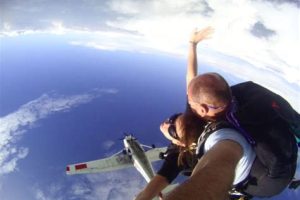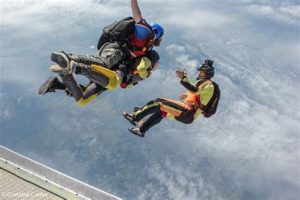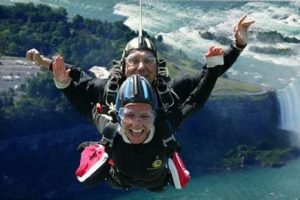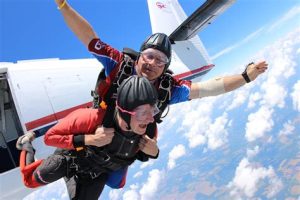Table of Contents
The average tandem skydiving height typically ranges between 10,000 to 14,000 feet above ground level. Discover the exhilarating experience of freefalling while securely harnessed to an experienced instructor. Enjoy breathtaking views and an adrenaline rush like no other!
Are you ready to experience the ultimate adrenaline rush? Look no further than tandem skydiving, an exhilarating adventure that allows you to soar through the sky while securely attached to an experienced instructor. But what exactly is the average height at which tandem skydiving takes place? Strap in as we take you on a journey to discover the thrilling heights reached during this heart-pounding activity. From the moment you step onto the plane to the moment you freefall through the clouds, every second of this skydiving experience will leave you breathless and craving more. So, let’s dive into the world of tandem skydiving heights and get ready to feel the rush like never before!
Introduction
Welcome to this informative article about the average tandem skydiving height! If you’ve ever been curious about the altitude at which tandem skydivers jump from, you’re in the right place. In this article, we will explore the typical heights at which tandem skydiving experiences take place, providing you with important insights into this thrilling adventure.
Understanding Tandem Skydiving
Before we delve into the average heights, let’s briefly understand what tandem skydiving entails. Tandem skydiving is a type of skydiving where an experienced instructor and a novice skydiver jump together using a single parachute. The instructor guides and controls the entire skydive, allowing the participant to enjoy the experience without the added responsibility.
Typical Heights for Tandem Skydiving
When it comes to the average tandem skydiving height, it typically ranges between 10,000 to 14,000 feet above ground level. This altitude provides a perfect balance between the thrill of freefall and the duration of the overall experience. At these heights, participants can enjoy breathtaking views and an adrenaline rush unlike any other.
Freefall Phase
Once the tandem pair jumps from the aircraft, they enter the exhilarating freefall phase. During this portion of the skydive, the participants experience a thrilling rush as they plummet towards the earth at speeds exceeding 120 miles per hour. The average duration of freefall in tandem skydiving is approximately 30 to 60 seconds, depending on the altitude.
Canopy Flight
After the freefall phase, the instructor deploys the parachute, and the tandem pair transitions into the canopy flight. This is when the parachute opens, and the descent slows down significantly. Canopy flight allows participants to take in the stunning aerial views while enjoying a peaceful and controlled descent towards the landing area.
Factors Affecting Tandem Skydiving Heights
The choice of tandem skydiving height can be influenced by various factors. Some common considerations include weather conditions, aircraft performance, drop zone regulations, and individual preferences. Safety is always the top priority, and experienced skydiving professionals make the final decision regarding the appropriate altitude for each jump.
Training and Safety Measures
Prior to the tandem skydive, participants receive thorough training from their instructors to ensure a safe and enjoyable experience. The instructors are highly trained professionals who possess extensive knowledge of skydiving techniques, safety protocols, and emergency procedures. They equip participants with the necessary skills and knowledge to handle the adventure confidently.
Choosing a Tandem Skydiving Height
When booking a tandem skydiving experience, the specific altitude may vary depending on the skydiving center and location. It is important to communicate your preferences and expectations to the skydiving professionals, who can guide you in selecting the appropriate height for your jump. They will consider your comfort level, desired freefall duration, and other factors to ensure you have a memorable experience.
Conclusion
Tandem skydiving is an incredible adventure that allows individuals to experience the thrill of freefalling from thousands of feet above the ground. The average tandem skydiving height ranges from 10,000 to 14,000 feet, providing participants with an unforgettable rush and awe-inspiring views. Remember, safety always comes first, and it’s essential to trust the expertise of your instructors throughout the entire experience. So, if you’re ready to conquer the skies, book your tandem skydive today and get ready for the adventure of a lifetime!
Introduction:
Welcome to the instructions and information section for average tandem skydiving heights. It is important to understand the heights involved in this thrilling activity to ensure your safety and enjoyment. Please read the following subheadings to gain a comprehensive understanding of tandem skydiving heights.
Definition of Average Tandem Skydiving Height:
The average tandem skydiving height refers to the altitude at which the jump takes place. It is the height at which the tandem pair exits the aircraft before beginning their exhilarating descent towards the ground.
Typical Tandem Skydiving Heights:
In most tandem skydiving experiences, the recommended altitude for the jump usually ranges between 10,000 to 14,000 feet. At this height, participants get the opportunity to enjoy breathtaking views while experiencing the adrenaline rush of freefall before the parachute is deployed.
Factors Influencing Tandem Skydiving Heights:
Various factors can influence the chosen tandem skydiving height, such as weather conditions, aircraft capabilities, and local regulations. These factors may vary from one skydiving center to another, so it is essential to check with your specific diving provider for their altitude guidelines.
Safety Considerations and Minimum Altitude:
Tandem skydiving centers prioritize safety, and therefore, there is generally a minimum skydiving altitude required for the jump. This minimum altitude is typically around 8,000 to 10,000 feet, ensuring enough time for the instructor to provide proper instructions and for a safe parachute deployment.
Scenic Skydiving Altitudes:
For those seeking a more visually stunning experience, some skydiving centers may offer higher altitude options. Scenic skydiving altitudes can range from 14,000 to 18,000 feet, allowing participants to enjoy even more breathtaking panoramic views during their freefall.
Skydiving Licenses and High-Altitude Jumps:
Certified skydivers with appropriate licenses and training have the opportunity to partake in high-altitude jumps that go beyond the typical tandem skydiving heights. These experienced divers can skydive from heights exceeding 20,000 feet, which provide unique challenges and unparalleled thrills.
Conclusion:
Having a clear understanding of the average tandem skydiving heights is crucial before embarking on this exhilarating adventure. Always ensure you check with the specific skydiving center for their altitude guidelines and safety protocols to have a safe and unforgettable skydiving experience. Remember to follow the instructions of your instructor and enjoy the breathtaking views during your tandem skydive.
From the point of view of average tandem skydiving height, there are several important instructions that need to be followed in order to ensure a safe and enjoyable experience. Here is a breakdown of these instructions:
-
Arrival at the drop zone: Arrive at the designated drop zone on time and ready for your skydiving adventure. This includes wearing appropriate clothing and footwear.
-
Pre-jump briefing: Listen attentively to the pre-jump briefing provided by the skydiving instructor. Pay close attention to the safety guidelines, equipment usage, and body positioning during the jump.
-
Gearing up: Allow the instructor to assist you in putting on the necessary skydiving gear, including the jumpsuit, harness, helmet, and goggles. Make sure everything fits properly and feels comfortable.
-
Boarding the aircraft: Follow the instructions of the instructor when boarding the aircraft. Be aware of any specific seating arrangements or safety procedures that need to be followed.
-
In-flight instructions: During the ascent to the desired skydiving altitude, listen to any additional instructions given by the instructor. This may include reminders about body positioning, communication signals, and what to expect during the jump.
-
Exit procedure: When it’s time to exit the aircraft, maintain the correct body posture as instructed by the instructor. This typically involves arching your back, keeping your head up, and legs bent at the knees.
-
Freefall experience: Enjoy the exhilarating sensation of freefall while following any hand signals or communication cues from the instructor. Keep your body relaxed and enjoy the breathtaking views.
-
Canopy deployment: At the predetermined altitude, the instructor will deploy the parachute. Follow any instructions given for a smooth transition from freefall to a controlled descent under the canopy.
-
Landing procedure: As you approach the landing area, lift your legs up as instructed by the instructor to prepare for a safe landing. Follow any additional guidance provided to ensure a soft and controlled touchdown.
-
Post-jump debriefing: After landing, take the time to debrief with the instructor. This is an opportunity to ask questions, share your experience, and receive feedback on your skydiving skills.
Remember, following these instructions and listening to the guidance of your tandem skydiving instructor are crucial for a safe and enjoyable experience. So, relax, enjoy the adventure, and make memories that will last a lifetime!
Thank you for visiting our blog today! We hope that you have found our article on average tandem skydiving height to be informative and helpful. If you are considering experiencing the thrill of tandem skydiving, it is important to understand the heights at which these jumps typically take place. In this closing message, we will summarize the key points discussed in the article and provide some final tips for your tandem skydiving adventure.
Firstly, it is important to note that the average tandem skydiving height can vary depending on various factors such as location, weather conditions, and the specific drop zone you choose. However, most tandem skydives typically take place at an altitude of around 10,000 to 14,000 feet above ground level. This allows for a thrilling freefall experience while ensuring a safe and enjoyable jump for both you and your instructor.
During the freefall portion of your tandem skydive, which lasts for about 30 to 60 seconds, you will experience an adrenaline-pumping rush as you plummet through the air at speeds of up to 120 miles per hour. The sensation of freefalling from thousands of feet above the ground is truly exhilarating and unlike anything else you will ever experience. After the freefall, your parachute will be deployed, and you will enjoy a peaceful and scenic descent back to the ground, giving you the opportunity to take in the breathtaking views from a unique perspective.
As you prepare for your tandem skydiving adventure, there are a few tips that we would like to share with you. Firstly, make sure to dress comfortably and wear appropriate clothing for the weather conditions at the drop zone. It is also a good idea to bring a pair of closed-toe shoes to ensure safety during the jump. Additionally, be sure to follow any instructions given by your instructor and ask any questions you may have before the jump. Remember, tandem skydiving is an incredible experience that should be enjoyed to the fullest, so don’t forget to relax, have fun, and embrace the thrill of soaring through the sky!
We hope that our article has provided you with valuable information about average tandem skydiving height and has inspired you to embark on your own skydiving adventure. Whether you are a first-time jumper or a seasoned skydiver, this exhilarating activity offers a unique perspective and an unforgettable experience. So, take the leap, spread your wings, and enjoy the thrill of tandem skydiving!
Thank you once again for visiting our blog, and we wish you the best of luck on your upcoming tandem skydive!
Video Average Tandem Skydiving Height
Here are some common questions that people also ask about the average tandem skydiving height:
-
What is the average altitude for a tandem skydive?
The average altitude for a tandem skydive is around 10,000 to 14,000 feet above ground level.
-
Why is the jump altitude important in tandem skydiving?
The jump altitude is important in tandem skydiving as it allows for a sufficient freefall duration and provides ample time to deploy the parachute safely.
-
How long does the freefall last during a tandem skydive?
The freefall during a tandem skydive typically lasts around 30 to 60 seconds, depending on the jump altitude and other factors.
-
Is it possible to skydive from a higher altitude?
Yes, it is possible to skydive from higher altitudes, such as 18,000 feet or even higher. However, these jumps are usually reserved for experienced skydivers and require specialized equipment.
-
Does the jump altitude affect the overall experience of tandem skydiving?
Yes, the jump altitude can greatly impact the overall experience of tandem skydiving. Higher altitudes provide a longer freefall, more time to take in the scenery, and an increased adrenaline rush.
Remember, always follow the specific instructions provided by your tandem skydiving instructor for a safe and enjoyable experience.






